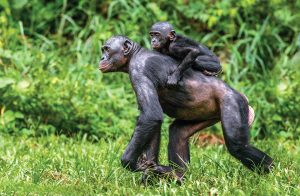
Bonobos and chimpanzees look very similar and both share 98.7% of their DNA with humans. This makes them the two species that are our closest living relatives. Bonobos are usually a bit smaller, leaner and darker than chimpanzees.
Wild bonobos can only be found in forests south of the Congo River in the Democratic Republic of Congo (DRC). Sometimes known as the pygmy chimpanzee, bonobos weren’t recognized as a separate species until 1929. Much remains unknown about the bonobo including the extent of its geographic range. Efforts to survey the species over the past two decades have been hampered by the remote nature of its habitat, the patchiness of their distribution, and years of civil unrest within the DRC. Therefore, there is a wide range of population estimates, which is between 10,000 and 50,000.
The bonobo is distinguished by relatively long legs, pink lips, dark face, tail-tuft through adulthood, and parted long hair on its head. Adult males weigh between 75 – 130 lbs. and females weigh an average of 66 lbs. Historically they were referred to as pygmy chimpanzees because of the similar features.


Bonobos feed mainly in trees and descend to the ground to move to other trees. They eat mostly fruits and other vegetation, such as herbs and roots. The diet is supplemented by caterpillars and earthworms. Bonobos confine their hunting to forest antelopes, squirrels, and rodents.
Males and females, old and young, male, and female bonobos are sexually active for more of the time than their chimpanzee counterparts; they bear offspring at roughly five-year intervals and resume copulating with males within a year of giving birth.
Bonobos communicate primarily through vocal means; however, the meanings are not currently known. They also use facial expressions and hand gestures that are mostly understood by humans.
Sexual activity generally plays a major role in bonobo society, being used as what some scientists perceive as a greeting, a means of forming social bonds, and a means of conflict resolution. Bonobos are the only non-human animals to have been observed engaging in tongue kissing.
They form communities usually numbering from 30 to more than 100 individuals. Their society is also different. Bonobo groups tend to be more peaceful and are led by females.
They also maintain relationships and settle conflicts through sex. However, bonobo life isn’t entirely violence-free; there is sometimes fighting between different groups of bonobos.
Civil unrest and increasing poverty in the area around the bonobos’ forests have contributed to bonobo poaching and deforestation. Though the size of the bonobo population is largely unknown, it has likely been declining for the last 30 years. Scientists
believe that the decline will continue for the next 45 to 55 years due to the bonobo’s low reproductive rate and growing threats.
The number of bonobos in the wild is shrinking because of human destruction of forests and illegal hunting for meat. Bonobos are not often kept in captivity.

Here are some of the personality traits of the Bonobo:
Intelligent
Kanzi, perhaps the world’s most famous bonobo, learned to communicate with humans via symbols called lexigrams. He reportedly mastered over 300 of them and understands up to 3000 spoken words.
Empathic
Bonobos are keen observers of the emotional states of others. They comfort distressed friends with hugs and other signs of affection, just like we do.
Matriarchal
Unique among great apes, bonobo society revolves around the females and female-based relationships. Rather than a strict hierarchy led by an alpha male, bonobo groups are led by ranking females and are more egalitarian.
Peaceful
Both within and between groups, bonobos tend to resolve conflict through affection rather than aggression. Unlike many other animals, bonobos are neither territorial nor hostile to strangers. When two bonobo groups encounter each other, they will frequently share food and engage in intimate behaviors.
Loving
Bonobos are sometimes referred to as the “Make Love, Not War” apes. They are famous for their creative and wide-ranging sexual activities. Sexual contact goes far beyond reproduction and is used for social bonding, pleasure, play, greeting, and conflict resolution. Bonobos partner without regard to age, sex, number, or reproductive status.
Playful
Bonobos love to play, whether it’s a game of chase with friends or exploring their environment on their own. They even laugh when they’re tickled! In the wild, bonobos are imaginative problem-solvers. In captivity, some bonobos have proven to be talented painters and musicians.
